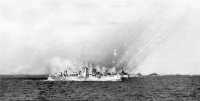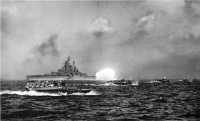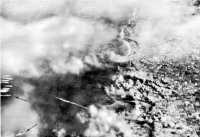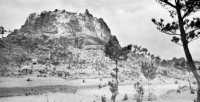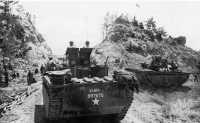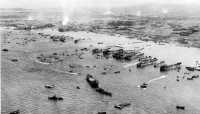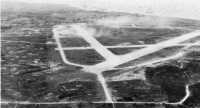Chapter 3: Winning the Okinawa Beachhead
Dawn of Easter Sunday, 1 April 1945, disclosed an American fleet of 1,300 ships in the waters adjacent to Okinawa, poised for invasion. Most of them stood to the west in the East China Sea. The day was bright and cool – a little under 75°; a moderate east-northeast breeze rippled the calm sea; there was no surf on the Hagushi beaches. Visibility was 10 miles until 0600, when it lowered to from 5 to 7 miles in the smoke and haze. More favorable conditions for the assault could hardly be imagined.
The Japanese doubtless marveled at the immensity of the assemblage of ships, but they could not have been surprised at the invasion itself. The Kerama Islands had been seized; Okinawa had been heavily bombarded for days; and underwater demolition teams had reconnoitered both the Hagushi beaches and the beaches above Minatoga on the southeast coast, indicating that landings were to be expected at either place or both. Moreover, Japanese air and submarine reconnaissance had also spotted the convoys en route.1
The Japanese had been powerless to interfere with the approach to the Ryukyus. Bad weather, however, had caused not only seasickness among the troops but also concern over the possibility that a storm might delay the landings. It was necessary for some convoys to alter their courses to avoid a threatening typhoon. The rough seas caused delays and minor damage and resulted in other deflections from planned courses. Thus on the evening before L Day various task forces converging on Okinawa were uncertain of their own positions and those of other forces. All arrived on time, however, and without mishap.2
For the men, observing the outline of the strange island in the first rays of light before the beaches became shrouded in the smoke and dust of naval and air bombardment, this Easter Sunday was a day of crisis. From scale models
of Okinawa studied on shipboard they had seen that the rising ground behind the landing beaches, and even more the island’s hills and escarpments, were well suited for defense. They had read of the native houses, each protected by a high wall, and of the thousands of strange Okinawan tombs which might serve the enemy as pillboxes and dugouts. They had been encouraged by the weakness of Kerama Retto’s defenses, but the generally held expectations of an all-out defense of the beaches on the first Japanese “home” island to be invaded was one to appall even the dullest imagination. And behind the beaches the men were prepared to meet deadly snakes, awesome diseases, and a presumably hostile civilian population.3
The Landing
H Hour had been set for 0830. At 0406 Admiral Turner, Commander of Task Force 51, signaled, “Land the Landing Force.”4 At 0530, twenty minutes before dawn, the fire support force of 10 battleships, 9 cruisers, 23 destroyers, and 177 gunboats began the pre-H-Hour bombardment of the beaches. They fired 44,825 rounds of 5-inch or larger shells, 33,000 rockets, and 22,500 mortar shells. This was the heaviest concentration of naval gunfire ever to support a landing of troops. About seventy miles east of Okinawa, Task Force 58 was deployed to furnish air support and to intercept attacks from Kyushu. In addition, support carriers had arrived with troop convoys. At 0745 carrier planes struck the beaches and near-by trenches with napalm.5
Meanwhile LSTs and LSMs, which had carried to the target both the men composing the first assault forces and the amphibian vehicles in which they were to ride, spread their yawning jaws and launched their small craft, loaded and ready for the shore. Amphibian tanks formed the first wave at the line of departure, 4,000 yards from the beach. Flagged on their way at 0800, they proceeded toward land at four knots. From five to seven waves of assault troops in amphibian tractors followed the tanks at short intervals.6
Opposite each landing beach, control craft, with pennants flying from the mast, formed the assault waves of amphibious vehicles in rotating circles. At 0815 the leading waves of amtracks uncoiled and formed a line near their mother control craft. Five minutes later the pennants were hauled down and an almost unbroken 8-mile line of landing craft moved toward the beaches.
Gunboats led the way in, firing rockets, mortars, and 40-mm. guns into prearranged target squares, on such a scale that all the landing area for 1,000 yards inland was blanketed with enough 5-inch shells, 4.5-inch rockets, and 4.2-inch mortars to average 25 rounds in each 100-yard square. Artillery fire from Keise added its weight. After approaching the reef, the gunboats turned aside and the amphibian tanks and tractors passed through them and proceeded unescorted, the tanks firing their 75-mm. howitzers at targets of opportunity directly ahead of them until landing. Simultaneously, two 64-plane groups of carrier planes saturated the landing beaches and the areas immediately behind with machine-gun fire while the fire from supporting ships shifted inland. When the assault wave moved in, the landing area had been under constant bombardment for three hours.7
As the small boats made their way steadily toward the shore the men kept expecting fire from the Japanese. But there was no sign of the enemy other than the dropping of an occasional mortar or artillery shell, and the long line of invasion craft advanced as though on a large-scale maneuver. The offshore obstacles had either been removed by the underwater demolition teams or were easily pushed over by the amphibian tractors. Some concern had been felt as to whether, despite the rising tide, the Navy landing boats would be able to cross the coral reef, and the first waves were to inspect the reef and send back information. The reef did not hinder the first waves, in amphibian vehicles, but those who followed in boats had difficulty and were therefore ordered to transfer at the edge of the reef and cross in LVTs.
Beginning at 0830, the first waves began to touch down on their assigned beaches. None was more than a few minutes late. The volume of supporting fire had increased until a minute or two before the first wave landed; then suddenly the heavy fire on the beach area ended and nothing was to be heard except the rumble of the shells that were shifted inland. Quickly the smoke and dust that had shrouded the landing area lifted, and it became possible for the troops to see the nature of the country directly before them. They
Bombarding the beaches directly preceded the landings. It was carried on at closest range by rocket gunboats of the U.S. Fleet. These boats led the way to the Hagushi beaches, turned aside just outside the reefs, and allowed amphibian tanks and tractors (below) to proceed ashore unescorted. Meanwhile the Tennessee and other American battleships kept up a steady support barrage
were on a beach which was generally about twenty yards in depth and which was separated by a 10-foot sea wall from the country beyond. There were few shell holes on the beach itself, but naval gunfire had blown large holes in the sea wall at frequent intervals to provide adequate passageways.8 Except at the cliff-bordered Bishi River mouth, in the center of the landing area, the ground rose gradually to an elevation of about fifty feet. There was only sparse natural vegetation, but from the sea wall to the top of the rise the coastal ground was well cultivated. In the background, along the horizon, hills showed through the screen of artillery smoke. Farther inland, in many places, towns and villages could be seen burning and the smoke rising above them in slender and twisted spires. These evidences of devastation, however, made less impression upon the men than did the generally peaceful and idyllic nature of the country, enhanced by the pleasant warmth, the unexpected quiet, and the absence of any sign of human life.
New waves of troops kept moving in. Before an hour had passed III Amphibious Corps had landed the assault elements of the 6th and 1st Marine Divisions abreast north of the Bishi River, and XXIV Corps had put ashore those of the 7th and 96th Infantry Divisions abreast south of that river. The 6th Marine Division and the 96th Division were on the flanks. Two battalion landing teams from each of two assault regimental combat teams in the four divisions, or more than 16,000 troops, came ashore in the first hour.9 (See Map 8)
The assault troops were followed by a wave of tanks. Some were equipped with flotation devices, others were carried by LCM(6)s which had themselves been transported by LSD’s, and still others were landed by LSMs. After debarking the assault waves, the amphibian tractors returned to the transfer line to ferry support troops, equipment, and supplies across the reef onto the beach. LVT, DUKW, and small-boat control points were established at the transfer line. Amphibian vehicles preloaded with ammunition and supplies proceeded inland as needed.10
The entire landing on Okinawa had taken place with almost incredible ease. There had been little molestation from enemy artillery, and on the beaches
The landings were made in amphibian craft which were shepherded to shore by control craft (arrows). heavy support fire which had blanketed the beaches with smoke and dust lifted seconds before the first troops touched down
Absence of enemy opposition to the landings made the assault seem like a large-scale maneuver as troops left their craft and quickly consolidated. Other waves followed closely
no enemy and few land mines had been encountered. The operation had taken place generally according to plan; there was little disorganization and all but a few of the units landed at the beaches assigned to them. The absence of any but the most trivial opposition, so contrary to expectation, struck the men as ominous and led them to reconnoiter suspiciously. After making certain that they were not walking into a trap, the troops began moving inland, according to plan, a very short time after they had landed.
Spirits rose as the marines and soldiers easily pushed up the hillsides behind the beaches. The land was dry and green with conifers and the air bracing – a welcome change from the steaming marshes and palm trees of the islands to the south. An infantryman of the 7th Division, standing atop a hill just south of the Bishi River soon after the landing, expressed the common feeling when he said, “I’ve already lived longer than I thought I would.”11
Simultaneously with the landing Maj. Gen. Thomas E. Watson’s Marine Division feinted a landing on Okinawa’s southeast coast, above Minatoga, with the hope of pinning down the enemy’s reserves in that area. This diversion simulated an actual assault in every respect. The first part of the demonstration group left Saipan on 25 March, and the main body arrived at Okinawa early in the morning of L Day. The Japanese attacked the force with their suicide planes, and one transport and an LST were damaged. Under cover of a smoke screen, seven boat waves, each composed of twenty-four LCVPs, carried 2nd Marine Division troops toward the beach. As the fourth wave crossed the line of departure at 0830 – H Hour for the main assault on the Hagushi beaches – all boats reversed course. By 1500 all the landing vessels had been recovered by their parent vessels. The only enemy reaction to the demonstration was one salvo of four rounds. The next day the demonstration was repeated, and the marines retired from the area. Proudly the Japanese boasted that “an enemy landing attempt on the eastern coast of Okinawa on Sunday morning [1 April] was completely foiled, with heavy losses to the enemy.”12
Moving Inland
Having ascended the slight hills at the landing beaches, the troops moved inland cautiously. Their immediate objectives were the two airfields, Kadena and Yontan, each about a mile inland. At 1000 the 27th RCT of the 7th Division
had patrols on Kadena airfield, which was found to be deserted, and at 1030 the front line was moving across the airstrip. A few minutes later it was 200 yards beyond. With similar ease the 4th Marines of the 6th Marine Division captured the more elaborate Yontan airfield by 1130. Wrecked Japanese planes and quantities of supplies were strewn about on both fields.13
By nightfall the beachhead was 15,000 yards long and in places as much as 5,000 yards deep. More than 60,000 men were ashore, including the reserve regiments of the assault divisions. All divisional artillery landed early, and, by dark, direct-support battalions were in position. Numerous tanks were ashore and operating, as well as miscellaneous antiaircraft artillery units and 15,000 service troops. Kadena airfield was serviceable for emergency landings by the evening of the first day. The 6th Marine Division halted for the night on a line running from Irammiya to the division boundary below Makibaru. The 7th Division had pressed inland nearly three miles, knocking out a few pillboxes and losing three tanks to mines. On the southern flank, the 96th Division had established itself at the river south of Chatan, on the high ground northwest of Futema, in the outskirts of Momobaru, and in the hills northwest and southwest of Shido. There were gaps in the lines in many places, but before nightfall they had been covered by reserve units or by weapons.14
Although in the hills around Shuri the enemy had superb observation of the Hagushi beaches and of the great American armada that stood off shore, he had been content for the time being to leave the burden of opposition to the Japanese air force. Some delaying actions were fought by small groups of Japanese, and some rounds of artillery and mortar fire were directed at the landing craft and the beaches, but the total resistance was negligible.
In the air the enemy did his best, but did not inflict much damage. Thrown off balance by the strikes of Task Force 58 against the airfields on Kyushu on 18-19 March, Japanese air resistance to the landings was aggressively pressed home but was small in scale. Suicide hits were scored on the battleship West
Virginia, two transports, and an LST; another LST was damaged by a suicide plane’s near miss, and two ships were damaged in other ways.15 An indefinite number of Japanese planes were shot down during the day by ships’ fire and defending fighters.16
Favored by perfect weather and light resistance, American forces moved swiftly during the next two days, 2 and 3 April. By 1400 on 2 April the 17th Infantry, 7th Division, had established itself on the highlands commanding Nakagusuku Bay, on the east coast, and had extended its patrols to the shore of the bay. The speed of its advance had left the units on its flanks some distance behind. To the south the 32nd Infantry came abreast late in the afternoon of 2 April, after reducing a strong point south of Koza with tanks. To the north, where the 1st Marine Division had encountered rugged terrain and difficult supply problems, a 6,000-yard gap was taken over by the 184th Infantry. Okinawa was now cut in two, and units of the Japanese Army in the northern and southern parts of the island were separated.17
The 96th Division made slow progress during the morning of 2 April in the country around Shido. Here it found heavily forested ridges, empty caves and dugouts, and mines and tank traps along the rough trails. Before evening the 381st Infantry had pushed through Shimabuku but had been stopped by enemy opposition in and around Momobaru. After a sharp fight the 383rd Infantry took a hill just south of Momobaru, and with the help of an air strike, artillery, and tanks it reduced a ridge northeast of Futema. That night its lines stretched from the west coast just north of Isa to a point southwest of Futema on the Isa–Futema road and along the northern edge of Futema.18
On 3 April XXIV Corps turned its drive southward. Leaving the 17th Infantry to guard and consolidate its rear, the 32nd Infantry pushed all three of its battalions southward along Nakagusuku Bay. After gaining 5,000 yards it occupied Kuba and set up its lines in front of Hill 165, the coastal extremity of a line of hills that swept southwest of the village. Fire was received from the hill, and a few Japanese were killed in a brief fire fight. Ten rounds of enemy artillery were received in the regiment’s sector, a sign of awakening resistance.19
Coordinating their advance with that of the 32nd Infantry on their left, elements of the 96th Division moved toward Hill 165 and Unjo. An unsuccessful attempt was made to take the hill. Other 96th Division units advanced to positions in the vicinity of Kishaba and Atanniya and northeast of Nodake. Futema and the high ground 600 yards south of it were taken. On the west flank the division’s line went through Isa to the southeastern edge of Chiyunna.20
Having completed its wheeling movement to the right, the 96th Division was ready to drive south in conjunction with the 7th Division. Civilians and prisoners of war stated that Japanese troops had withdrawn to the south. XXIV Corps now changed the boundary line between its two assault divisions. On the next day, 4 April, four regiments were to move into line across the narrow waist of the island-the 32nd and the 184th of the 7th Division on the east, and the 382nd and the 383rd of the 96th Division on the west. The real battle for Okinawa would then begin.21
Meanwhile, in the zone of III Amphibious Corps, the 1st Marine Division continued on 2 April 1945 to the line Ishimmi–Kutoku and Chatan. It met a few small pockets of resistance but was slowed mainly by the primitive roads and rough terrain. On the following day this division again advanced against little opposition, its forward elements reaching Nakagusuku (Buckner) Bay by 1600. At the same time its reconnaissance company explored Katchin Peninsula and the east coast roads north to Hizaonna. On 4 April all three regiments of the 1st Marine Division were on the eastern shore of Okinawa, and the division’s zone of action was completely occupied.22
On L plus 1, the 6th Marine Division continued its advance into the foothills of Yontan–Zan, patrolled the peninsula northwest of the Hagushi beaches, and captured the coastal town of Nagahama. In this mountainous sector, well-worn trails crisscrossed the wooded hills and ridges, and caves pitted the coral walls and steep defiles. By manning both ridge tops and caves, the Japanese put up tenacious resistance. The 6th Marine Division killed about 250 of the enemy in two such strong points on 2 April. Next day it advanced 7,000 yards, the 22nd Marines on the left maintaining supply through rough wild country by “weasels.” One more day’s march would bring this division to the L-plus-15 line drawn from Nakodamari to Ishikawa.23
Moving inland, American troops at first met little or no opposition. South of Kadena airfield, in coral crags deeply scarred by naval bombardment, 96th Division infantrymen engaged in their first hill and cave fighting in Okinawa
96th Division troops in amphibian tanks turned south on the right flank and paused just north of Sunabe to reconnoiter; here they raised the American flag
The tempo of Japanese air attacks increased somewhat during the first three or four days after L Day, and many ships were damaged and some lost during this period. Vessels not actually engaged in unloading withdrew some distance from Okinawa each night, but this did not make them proof against attack. The Henrico, an assault transport carrying troops and the regimental staff of the 305th Infantry, 77th Division, was crashed by a suicide plane south of the Keramas at 1900 on 2 April. The plane struck the commodore’s cabin and plunged through two decks, its bomb exploding on the second deck. The commodore was killed, as were also the commanding officer, the executive officer, the S-1, and the S-3 of the 305th. The ship’s total casualties were 30 killed, 6 missing, and 50 injured.24
Organizing the Beachhead
The first waves of the troops were no sooner across the beaches and moving up the slopes than the complex machinery of supplying them, planned in intricate detail over long months, went into action. The problem was to move food, ammunition, and equipment for more than 200,000 men across beaches with a fringing reef from 200 to 400 yards wide25 to dumps in rear areas, and then to the troops; to widen the native roads; to repair the captured airfields; and to alleviate the inevitable distress of the civilian population while rendering it incapable of interference.
While the beaches varied widely in serviceability, they were in general well adapted to unloading purposes. LCMs and LCVPs could cross the reef for four or five hours at each flood tide and unload directly on the beach; during middle and low tides their cargoes had to be transferred to amphibian vehicles at transfer barges. LSTs, LSMs, and LCTs were beached on the reef at high tide to enable vehicles and equipment to be discharged during the next low tide, and the bulk cargo by DUKW’s and LVTs at any tide. Various expedients were used to hasten the unloading. Night unloading under floodlights began on a April, and the work proceeded without interruption except when enemy aircraft was in the vicinity. Ponton causeways accommodating LSTs were established at predetermined sites. By 4 April a T-pier, with a 300-foot single-lane approach and a 30- by 170-foot head, and a U-pier,
with two 500-foot approaches and a 60- by 175-foot wharf section, had been set up on the beaches. The piers were soon supplanted by six single-lane causeways. By the same day an L-shaped pier, with a 1,400 foot single-lane approach and a 45- by 175-foot head, had been completed. Several sand piers were also constructed. As the marines rolled northward, additional unloading points were established as far north as Nago. Ponton barges carried to Okinawa on cargo ships were assigned varying jobs from day to day. By 11 April, 25 had been equipped with cranes and were operating as transfer barges, 53 were operating as lighters, and 6 as petroleum barges, while 8 were being used for evacuating casualties. A crane barge was capable of handling 400 tons in a 20-hour day when enough amphibian vehicles were available to make the runs ashore.26
Control of operations on the beaches, initially in the battalion landing teams, passed step by step through the echelons of command until Tenth Army, acting through the Island Command and the 1st Engineer Special Brigade, assumed responsibility on 9 April. Navy beachmasters maintained liaison with the ships and scheduled the beaching of landing ships and the assignment of lighterage. General unloading began on 3 April. It was soon apparent that the limiting factor was the availability of transport from the beaches to the dumps. The shortage of service units and equipment due to space limitations was immediately felt, especially in the Army zone; the problem was eased for the Marines by the use of 5,000 replacements landed with the Marine divisions. The rapidity of the advance and the immediate uncovering of Yontan and Kadena airfields required a rearrangement of supply priorities. The difficulties in initiating so intricate an undertaking near the enemy’s homeland were prodigious, and it required time and the process of trial and error to overcome them. Suicide planes and suicide boats were a constant menace, and on the afternoon of 4 April the weather came to the aid of the enemy. A storm, bringing with it from 6- to 10-foot surf on the Hagushi beaches, lasted through the night and the following day. All unloading ceased, and some landing craft hit against the reef and were damaged. Again on 10 April surf backed by a high wind brought work to a standstill, and on 11 April conditions were but slightly improved. Rain accompanying these storms made quagmires of the roads and further complicated the supply problems. Despite these handicaps, the assault shipping was 80 percent unloaded by
16 April, and 577,000 measurement tons had crossed the Hagushi beaches, a larger amount than had been anticipated in the plans.27
In addition to beach installations, base facilities necessary for the immediate success of the operation had to be developed quickly. Existing roads had to be improved and new roads built; the two airfields required repairs and expansion; and facilities for bulk storage of petroleum products, especially aviation gas, with connections to tankers off shore, were urgently needed. It was not long before the road down the west coast of Okinawa blossomed with markers which proclaimed it “US 1,” and route numbers were similarly assigned to all main roads as they were taken, in accordance with the Engineers’ plans. Okinawa’s roads were, for the most part, unsurfaced and only one or one and one-half lanes in width. On L Day beach-exit and shore-party dump roads were improved; next, the main supply routes to the troops and roads to permanent and semipermanent supply installations. During the rains of 4-5 and 10-11 April the spinning wheels of endless lines of trucks soon tore through the crusts of the more traveled highways and became mired. In dry weather the surface became pulverized, and the heavy military traffic raised clouds of dust that sometimes cut visibility to the length of the hood. Engineers widened and resurfaced the main thoroughfares, using coral from existing and newly opened pits, coral sand, rubble from destroyed villages, and limestone. Bridges that were too narrow or too weak to carry American trucks and tanks were soon replaced by Bailey bridges, which could be set up and taken down much in the fashion of an Erector span. It was late in April before equipment was available for the construction of gasoline tank farms.28
An area 30 feet by 3,000 feet on the Yontan runway was cleared and the bomb craters filled on L Day; by the evening Kadena was also ready for emergency landings.29 Nineteen artillery spotting planes were flown in from CVE’s and LSTs on 2 April and began operations on 3 April.30 The work of conditioning the two fields began in earnest the following day.31 Land-based fighter groups arrived at Yontan on 7 April and at Kadena two days later, improving local control of the air and making more aircraft available for support. Air
Supplying and developing the beachhead had by L plus 3 made substantial progress. Supply ships were run in to the reef’s edge, where they unloaded into trucks or amphibian vehicles. Indentation in shore line is Bishi River mouth, with Yontan airfield on horizon beyond; one runway (below) had been sufficiently repaired to allow use of land-based fighter planes
evacuation of the wounded to the Marianas by specially equipped C-54’s began on 8 April.32 At the same time a C-47 equipped for spraying DDT was brought into Yontan to take over the sanitation mission performed since a April by carrier-based aircraft.33 The 69th Field Hospital landed on 3 April and received its first casualties two days later. Until it was established, the divisions had evacuated their casualties immediately by LCVPs and DUKW’s to one of eight LST(H)s lying off the Hagushi beaches. Each hospital ship could take care of 200 patients and perform emergency surgery. By 16 April Army and Marine hospitals ashore had a capacity of 1,800 beds.34
Thousands of destitute Okinawans, dazed by the preinvasion bombardment of their island and the swift advance of the Americans, entered the custody of the Military Government authorities almost at once. Initially placed in stockades to keep them out of the way, they were quickly moved to selected villages which had escaped destruction. Thus by 5 April 1,500 civilians held in a barbed wire enclosure just south of Kadena were being moved by truck to Shimabuku, where they would have freedom of movement within boundaries established by the military police. Other collection points were similarly emptied and closed.35
Thus, in an amazingly short time the beachhead had been won and the supply lines established. By 4 April Tenth Army held a slice of Okinawa 15 miles long and from 3 to 10 miles wide. The beachhead included two airfields of great potentialities, beaches that could take immense tonnage from the cargo ships, and sufficient space for the dumps and installations that were rapidly being built. The months of planning and preparation had borne their first fruit.
